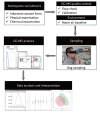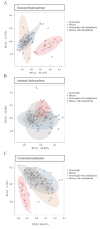Gas chromatography-mass spectrometry pilot study to identify volatile organic compound biomarkers of childhood obesity with dyslipidemia in exhaled breath
- PMID: 37223613
- PMCID: PMC10202018
- DOI: 10.2478/jtim-2022-0035
Gas chromatography-mass spectrometry pilot study to identify volatile organic compound biomarkers of childhood obesity with dyslipidemia in exhaled breath
Abstract
Objectives: Childhood obesity affects multiple organs in the body and is associated with both significant morbidity and ultimately premature mortality. Childhood obesity, especially dyslipidemia, can lead to early atherosclerosis and premature cardiovascular disease (CVD) in adulthood. The detection of exhaled volatile organic compounds (VOCs) in the breath offers the opportunity for the discovery of novel disease-specific biomarkers. This study aimed to identify VOCs that correlate with childhood obesity accompanied by dyslipidemia.
Methods: A total of 82 overweight or obese children between the ages of 8 and 12 years were recruited from the exercise on obesity adolescents in Peking (EXCITING) study (NCT04984005). The breath VOCs of the participants were measured by gas chromatography-mass spectrometry (GC-MS). The classification was performed using principal component analysis (PCA) of the relative abundance of VOCs. The difference between the obese and overweight groups with or without dyslipidemia was analyzed.
Results: Among the 82 children, 25 were overweight, of whom 10 had dyslipidemia. The other 57 children were obese, and 17 of them had dyslipidemia. Obese children with dyslipidemia had higher triglycerides and elevated non-high-density lipoprotein-cholesterol compared to overweight children without dyslipidemia. We confirmed 13 compounds based on database well matches (average score > 80) for mass spectra and refractive index. These 13 VOCs were grouped into three chemical functional groups: saturated hydrocarbons, aromatic hydrocarbons and unsaturated aldehydes. For obese children with dyslipidemia, the PCA scatter plot of the three chemical groups was obviously separated from the other groups. Some of the candidates, including heptadecane, naphthalene, and cis-6-nonnenol, were significantly higher in obese children with dyslipidemia than in overweight groups with or without dyslipidemia.
Conclusion: A suite of VOCs from three chemical function groups, saturated hydrocarbons, aromatic hydrocarbons, and unsaturated aldehydes, were separated in the obese children with dyslipidemia. Heptadecane, naphthalene, and cis-6-nonenol were significantly elevated in obese children with dyslipidemia. Our findings underscore the potential value of the candidate VOCs for future risk categorization.
Keywords: childhood; dyslipidemia; obesity; volatile organic compounds.
© 2023 Tan Xu, Jiaxing Wang, Jiang Tan, Tao Huang, Guojun Han, Yizhou Li, Haiyi Yu, Jiang Zhou, Ming Xu, published by Sciendo.
Conflict of interest statement
Conflict of Interest Ming Xu is an Editorial Board Member of the journal. The article was subject to the journal’s standard procedures, with peer review handled independently of this member and his research group.
Figures




References
-
- Horesh A, Tsur AM, Bardugo A, Twig G. Adolescent, Childhood Obesity, Excess Morbidity. Mortality in Young Adulthood-a Systematic Review. Curr Obes Rep. 2021;10:301–10. - PubMed
-
- Haworth JJ, Pitcher CK, Ferrandino G, Hobson AR, Pappan KL, Lawson JLD. Breathing new life into clinical testing and diagnostics: perspectives on volatile biomarkers from breath. Crit Rev Clin Lab Sci. 2022 - PubMed
LinkOut - more resources
Full Text Sources
Miscellaneous
